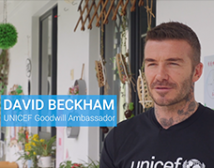The inaugural Tsinghua-UNICEF Youth Innovation Forum concluded on October 19, 2015. Over 200 students, development experts and industry leaders participated in the forum. The Global Innovation Centre for Children, Beijing, is a university-wide, long-term and strategic collaboration between Tsinghua and UNICEF. The Academy of Arts and Design is one of the main implementing entities at Tsinghua. Dean Lu Xiaobo shared with us the purpose and vision of this collaboration.
Q: Why do you support the establishment of the Global Innovation Centre for Children, Beijing?
A: We've always had a vision: the designers we train, their vision should not be restrained to the market; they should have hearts to serve the public. We emphasize public and social service, in particular, service for the most vulnerable children and women. The purpose of the Global Innovation Centre for Children, supported by UNICEF and Tsinghua, is to create innovative products and services for these beneficiaries. In my opinion, this is a great opportunity for our work and vision.
Q: Why do you choose to collaborate with UNICEF?
A: UNICEF is a United Nations agency tasked to promote children's rights globally. Tsinghua and UNICEF are aligned in their brands, and complement each other in terms of respective expertise. This collaboration may contribute to greater involvement of young people in developmental and philanthropic work.
For example, design is the strongest discipline at the Academy of Arts of Design. What do we design? What kind of future do we want to construct? This work cannot remain at conceptual stages; we hope to substantively contribute to social development and progress. UNICEF has offices or programmes in over 190 countries and regions, substantial field experience, as well as understanding of the needs and environments of target beneficiaries. This is critical for human-centered design.
Q: What is the relationship between innovation in design and social innovation?
A: What is the purpose of design? Design needs to create value. What kind of value? It certainly includes commercial value and the improvement of living standards; but more importantly, it has to create a more harmonious and joyful society. We have the responsibility to care for children, adolescents, women and vulnerable populations.
Q: In encouraging youth innovation, what roles do you see various sectors play?
A: The key to innovation is cross-sectoral collaborations. Students have many creative ideas and concepts, which all come from very good places. However, they need guidance from top-notch industry experts and support from all sectors of the society, in order to overcome difficulties, and turn their ideas into innovative products and services. Students focus on their studies. Support from various sectors will be important to really implement and scale-up innovations.
We would like to establish a platform convening industries, education and research. This would allow us to bring together cutting-edge research and industry know-how, and facilitate face-to-face communications between young students and leading experts. Through collaboration with UNICEF, international development experts and industry leaders, we can accelerate the start-up of innovations.
Q: What qualities do you hope students to acquire through social innovation-oriented education?
A: We currently have partnerships with many leading educational institutions globally. We have seen that many institutions with high social values and responsibilities have ongoing educational and research activities dedicated to create social and public service. These activities extend beyond commercial innovations, and can broaden young students' horizons.
The designers we educate and train should have more than high technical competency. The collaboration between UNICEF and Tsinghua University can convene global resources to jointly promote social services for children. This is important to us as we educate designers that are creative, competent and dedicated to social service.
Q: Are you concerned that social innovation-oriented education would hinder students employment in a highly competitive job market?
A: Use cases shared by UNICEF can help broaden and deepen students' understanding of their potential users and markets. These users are often underserved, the markets under-developed. This is because they currently have low income and low consumption power. However, these markets will be the largest and fastest growing ones in the coming decades. Understanding of these markets may benefit students' employment.
In addition, students may also enjoy interactions with industry leaders, which could have positive impact on their job searches or career development.




























